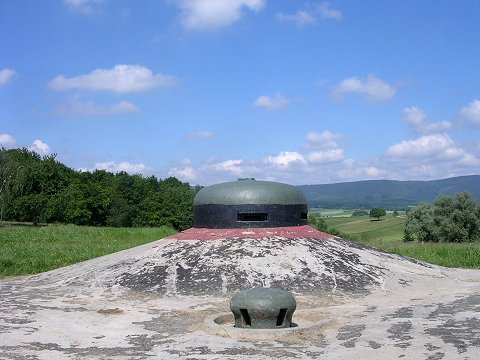|
Ouvrage Cap Martin
Ouvrage Cap Martin is a work (''gros ouvrage'') of the Maginot Line's Alpine extension, the Alpine Line, also called the Little Maginot Line. The ouvrage, located on high ground in Roquebrune, consists of two artillery blocks and one combination block facing Italy. The ''ouvrage'' was at the southernmost end of the Alpine Line and overlooked the Mediterranean Sea coastline at an altitude of 21 meters between Nice and Menton, facing towards Italy. The ''ouvrage'' and its advance casemate at Pont Saint Louis controlled the coastal roads along the Mediterranean. Description The ''ouvrage'' was built between October 1930 and October 1933 by a contractor named Borie, at a cost of 17 million francs, of which 1.6 million francs were for property acquisition and 2,776,000 francs were for the fort's armament.Mary, Tome 4, p. 29 Three observatories reported to Cap Martin.Mary, Tome 5, pp. 72–73 *Block 1 (entry): one FM embrasure, two machine gun cloches, one grenade launcher cloc ... [...More Info...] [...Related Items...] OR: [Wikipedia] [Google] [Baidu] |
Maginot Line
The Maginot Line (french: Ligne Maginot, ), named after the French Minister of War André Maginot, is a line of concrete fortifications, obstacles and weapon installations built by France in the 1930s to deter invasion by Germany and force them to move around the fortifications. The Maginot Line was impervious to most forms of attack. In consequence, the Germans invaded through the Low Countries in 1940, passing it to the north. The line, which was supposed to be fully extended further towards the west to avoid such an occurrence, was finally scaled back in response to demands from Belgium. Indeed, Belgium feared it would be sacrificed in the event of another German invasion. The line has since become a metaphor for expensive efforts that offer a false sense of security. Constructed on the French side of its borders with Italy, Switzerland, Germany, Luxembourg and Belgium, the line did not extend to the English Channel. French strategy therefore envisioned a move into Belgium ... [...More Info...] [...Related Items...] OR: [Wikipedia] [Google] [Baidu] |
VDP Cloche
The VDP cloche was an element of the Maginot Line fortifications. A ''cloche'' (bell) was a fixed and non-retractable firing position made of a thick iron casting which shielded its occupant. By comparison, turrets could be rotated and sometimes lowered so that only the top shell was exposed. VDP cloches were used for observation of the surrounding area for artillery direction. VDP is an acronym for ''Vision Directe et Périscopique''. By comparison with the GFM cloche, the VDP cloche had narrower ports and was consequently lower in profile. Description VDP cloches were equipped with three embrasures or crenels for direct vision, providing protection to observers. VDP cloches were also equipped with periscopes that allowed a greater arc of view. The cloches were embedded in a thick concrete carapace over a combat, entrance or observation block element of a largely subterranean Maginot fortification. A platform, identical to that used in the GFM cloche, was installed for the obser ... [...More Info...] [...Related Items...] OR: [Wikipedia] [Google] [Baidu] |
List Of Alpine Line Ouvrages
This is the list of all ''ouvrages'' of the Alpine Line or Little Maginot Line along the Franco-Italian border, organized by sector and type of fortification. ''Ouvrage'' translates as "works" in English; publications in both English and French refer to these fortifications in this manner, rather than as "forts". An ''ouvrage'' typically consists of a distributed series of concrete-encased strongpoints defending a region, linked by tunnels, as opposed to a fort, which typically refers to a defended surface enclosure, which may have underground galleries as an adjunct. For a list of the ''ouvrages'' of the main Maginot Line, refer to List of Maginot Line ouvrages. Voici la liste des ouvrages de la Ligne Maginot répartis par Secteurs Fortifiés et types d'ouvrages: Fortified Sector of Savoy (La Tarentaise) Ouvrage * 1 - Ouvrage Chatelard (PO) * 1 - Ouvrage Cave Canon (PO) Fortified Sector of Savoy (La Maurienne) Ouvrages * 2 - Ouvrage Sapey (GO) * 3 - Ouvrage Saint ... [...More Info...] [...Related Items...] OR: [Wikipedia] [Google] [Baidu] |
Crew Of The Casemate Of Pont Saint-Louis
A crew is a body or a class of people who work at a common activity, generally in a structured or hierarchical organization. A location in which a crew works is called a crewyard or a workyard. The word has nautical resonances: the tasks involved in operating a ship, particularly a sailing ship, providing numerous specialities within a ship's crew, often organised with a chain of command. Traditional nautical usage strongly distinguishes officers from crew, though the two groups combined form the ship's company. Members of a crew are often referred to by the title ''crewman'' or ''crew-member''. ''Crew'' also refers to the sport of rowing, where teams row competitively in racing shells. See also *For a specific sporting usage, see rowing crew. *For filmmaking usage, see film crew. *For live music usage, see road crew. *For analogous entities in research on human judgment and decision-making, see team and judge–advisor system. *For stagecraft usage, see stage crew. *For ... [...More Info...] [...Related Items...] OR: [Wikipedia] [Google] [Baidu] |
French Riviera
The French Riviera (known in French as the ; oc, Còsta d'Azur ; literal translation " Azure Coast") is the Mediterranean coastline of the southeast corner of France. There is no official boundary, but it is usually considered to extend from Toulon, Le Lavandou or Saint-Tropez in the west to Menton at the France–Italy border in the east."Côte d'Azur, côte méditerranéenne française entre Cassis et Menton" ("Côte d'Azur, French Mediterranean coast between Cassis and Toulon") in ''Dictionnaire Hachette encyclopédique'' (2000), p. 448."Côte d'Azur, Partie orientale du littoral français, sur la Méditerranée, de Cassis à Menton" ("Côte d'Azur, Eastern part of the French coast, on the Mediterranean, from Cassis to Menton"), in ''Le Petit Larousse illustré'' (2005), p. 1297. The coast is entirely within the Provence-Alpes-Côte d'Azur region of France. The Principality of Monaco is a semi-enclave within the region, surrounded on three sides by France and fronting the ... [...More Info...] [...Related Items...] OR: [Wikipedia] [Google] [Baidu] |
Armored Train
An armoured train is a railway train protected with armour. Armoured trains usually include railway wagons armed with artillery, machine guns and autocannons. Some also had slits used to fire small arms from the inside of the train, a facility especially prevalent in earlier armoured trains. For the most part they were used during the late 19th and early 20th centuries, when they offered an innovative way to quickly move large amounts of firepower. Most countries discontinued their use – road vehicles became much more powerful and offered more flexibility, and train tracks proved too vulnerable to sabotage and attacks from the air. However, the Russian Federation used improvised armoured trains in the Second Chechen War of 1999–2009 and the Russian invasion of Ukraine in 2022. Armoured trains were usually fighting systems, equipped with heavy weapons such as artillery. An exception was the US "White Train", the Department of Energy Nuclear Weapons Transport Train, armoured ... [...More Info...] [...Related Items...] OR: [Wikipedia] [Google] [Baidu] |
Artillery
Artillery is a class of heavy military ranged weapons that launch munitions far beyond the range and power of infantry firearms. Early artillery development focused on the ability to breach defensive walls and fortifications during sieges, and led to heavy, fairly immobile siege engines. As technology improved, lighter, more mobile field artillery cannons developed for battlefield use. This development continues today; modern self-propelled artillery vehicles are highly mobile weapons of great versatility generally providing the largest share of an army's total firepower. Originally, the word "artillery" referred to any group of soldiers primarily armed with some form of manufactured weapon or armor. Since the introduction of gunpowder and cannon, "artillery" has largely meant cannons, and in contemporary usage, usually refers to shell-firing guns, howitzers, and mortars (collectively called ''barrel artillery'', ''cannon artillery'', ''gun artillery'', or - a layman t ... [...More Info...] [...Related Items...] OR: [Wikipedia] [Google] [Baidu] |
Ouvrage Mont Agel
Ouvrage Mont Agel is a work (''gros ouvrage'') of the Maginot Line's Alpine extension, the Alpine Line, also called the Little Maginot Line. The 1930s ''ouvrage'' was built in and around the earlier mountaintop Fortress of Mont Agel. The ''ouvrage'' forms a backup to the main curtain of Alpine Line forts, and was not initially planned as part of the Alpine Line proper. Its intended function was primarily to provide heavy, long-range artillery support from a location well to the rear of the line. However, the planned 145mm heavy guns were never installed. Its site on Mont Agel, at an altitude of , is the highest point in the vicinity of Nice and Menton and commands the entire coastline, as well as the approaches from Sospel to the north. The site is now occupied by ''Base Aérienne 943'' of the French Air Force and functions as an air defense control station. Description The ouvrage consists of three entry blocks (including a terminal for an aerial tram) with a guard block, one ... [...More Info...] [...Related Items...] OR: [Wikipedia] [Google] [Baidu] |
Ouvrage Roquebrunne
Ouvrage Roquebrune is a work (''gros ouvrage'') of the Maginot Line's Alpine extension, the Alpine Line. The ouvrage consists of one entry block, two artillery blocks and one observation block facing Italy. The fortification is located on the heights behind Roquebrune at an elevation of 321 meters overlooking Cap Martin and the bays of Roquebrune and Menton. The ''ouvrage'' was manned by 293 men of the 58th Demi-Brigade Alpin de Forteresse (DBAF), supported by the 157th Régiment d'Artillerie de Position (RAP), under the command of Captain Gayot. Description The ''ouvrage'' was built between November 1931 and July 1933 by Thorrand et Cie., at a cost of 20.3 million francs.Mary, Tome 4, p. 29 *Block 1 (entry): Two FM embrasures, one machine gun cloche and one grenade launcher cloche. *Block 2: (artillery block) two 75mm guns, two 81mm mortars, one machine gun cloche and one grenade launcher cloche. *Block 3: (artillery block) two 75mm guns, two 81mm mortars, two machine g ... [...More Info...] [...Related Items...] OR: [Wikipedia] [Google] [Baidu] |
LG Cloche
The LG cloche was a defensive element common to many Maginot Line ''ouvrages''. The fixed cupola was deeply embedded into the concrete on top of a combat block, with only the top surface visible. The opening permitted the ejection of grenades from the interior of the cloche, providing a means of close defense against enemy troops on top of the bunker. 75 units were installed in the Maginot Line. LG refers to ''Lance-Grenade'' (grenade launcher). Unlike other cloches such as the GFM or the JM, the LG cloche was effectively "blind", possessing a single shuttered orifice in diameter in its flat crown. It had no observation ports at all, as it did not project appreciably above the surrounding surface. The LG cloche came in three models: a small version, high, a large version, and a cloche for two persons, tall. All were in diameter. LG cloches were usually found in the vicinity of an entrance block. The LG cloche was armed with a grenade launcher that could fire at an angle f ... [...More Info...] [...Related Items...] OR: [Wikipedia] [Google] [Baidu] |





